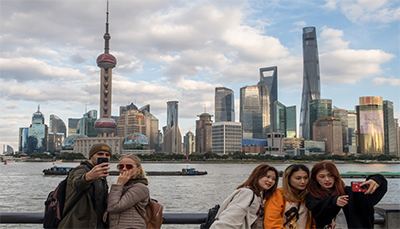



Tourists pose for photographs on the Bund, a major scenic spot on the Huangpu River, in Shanghai. [Photo by Wang Gang/For China Daily]
A development plan has been announced that Shanghai will develop the banks of the Huangpu River and the Suzhou Creek to create a world-class name card for the city. This plan is known as the river and creek project which has been included in the city's 14th Five-Year Plan (2021-2025). It focuses on the integrated development of the city's riverfronts, which offer green space for business and leisure and opportunity for cultural preservation.
With the plan, the areas along the Huangpu River will demonstrate the core competitiveness of Shanghai as a highly developed modern international metropolis. At the same time, the areas along Suzhou Creek will demonstrate the megacity's lively neighborhoods with multiple functions. In order to improve the environmental quality, the municipal government proposed to add 20 kilometers of waterfront leisure paths and 400 hectares of green space along the Huangpu River, which opened 45 km of riverside paths to the public in 2018. The riverside path along both sides of Suzhou Creek in the downtown area will be fully opened, along with 80 hectares of greenery.
In the aspect of historical heritage protection, the government will promote the preservation and renewal of 330,000 square meters of industrial relics, mostly deserted ports, factories and warehouses built from the 19th to the early 20th century. The industrial heritage should be revitalized to showcase the cultural elements of the city. At the same time, old architecture will be repaired and given new functions, such as making them as new landmarks and scenic spots. This will further create a new business development model in Shanghai with more commercial space created for business and office buildings. To protect the environment, an antipollution campaign will be carried out along the banks, around 4 sq km of riverside land will be recovered from other uses, and ecological corridors will be built in the 35 km upstream of Suzhou Creek, and at the intersection of the Huangpu and Dazhi rivers.
This way, the riverfronts will become a new world-class name card for Shanghai. Eight new rest spots along the Huangpu River and 12 rest spots along the Suzhou Creek will be built, providing various public services and making the riversides a living room for citizens. Around 50 rest spots are currently open along the Huangpu River, providing services such as toilets, shower rooms, small libraries and baby care facilities to the public.
The Bund, on the west bank of the Huangpu River, together with its northern extension, and the Lujiazui area on the opposite bank will continue to be the city's core business area. Along the southern part of the Huangpu River, the World Expo area, Qiantan and Xuhui Riversides will form a culture and museum zone to attract more high-end cultural facilities. On the Suzhou Creek, the area around East China University of Political Science and Law will focus on the preservation of historical buildings to showcase the history of the creek over the past century.
Edited by Wang Miao with reference to
<http://www.chinadailyglobal.com/a/202109/01/WS612ed3f1a310efa1bd66c7b7.html>